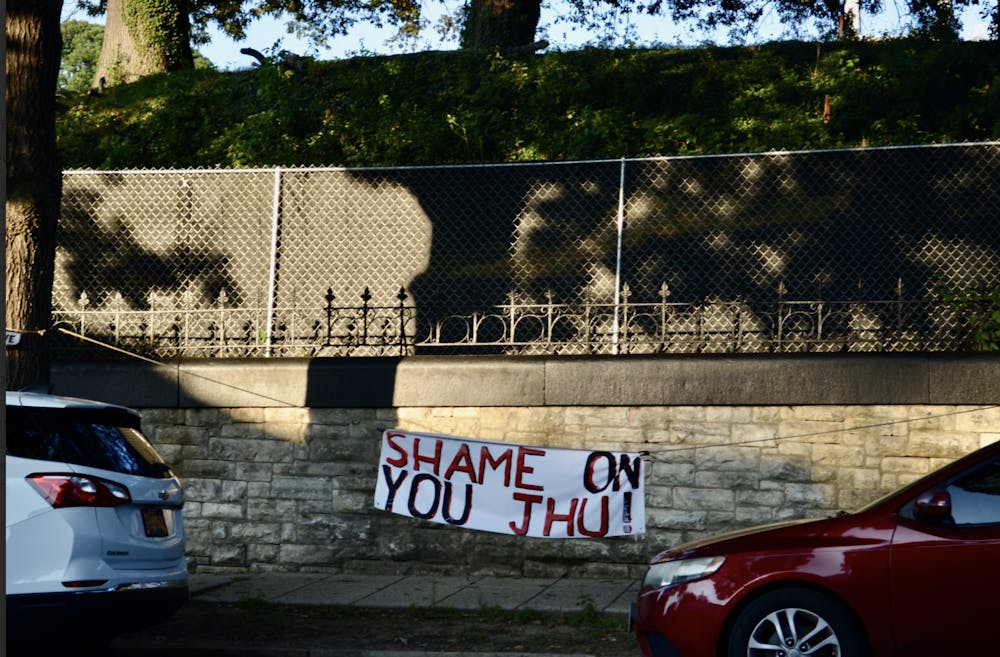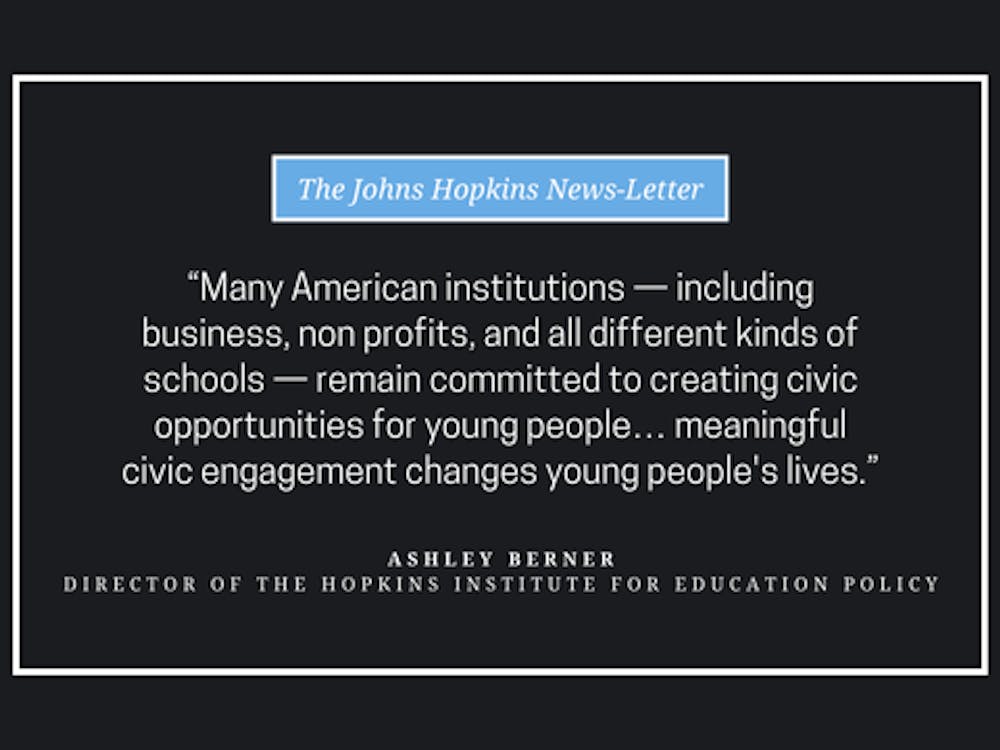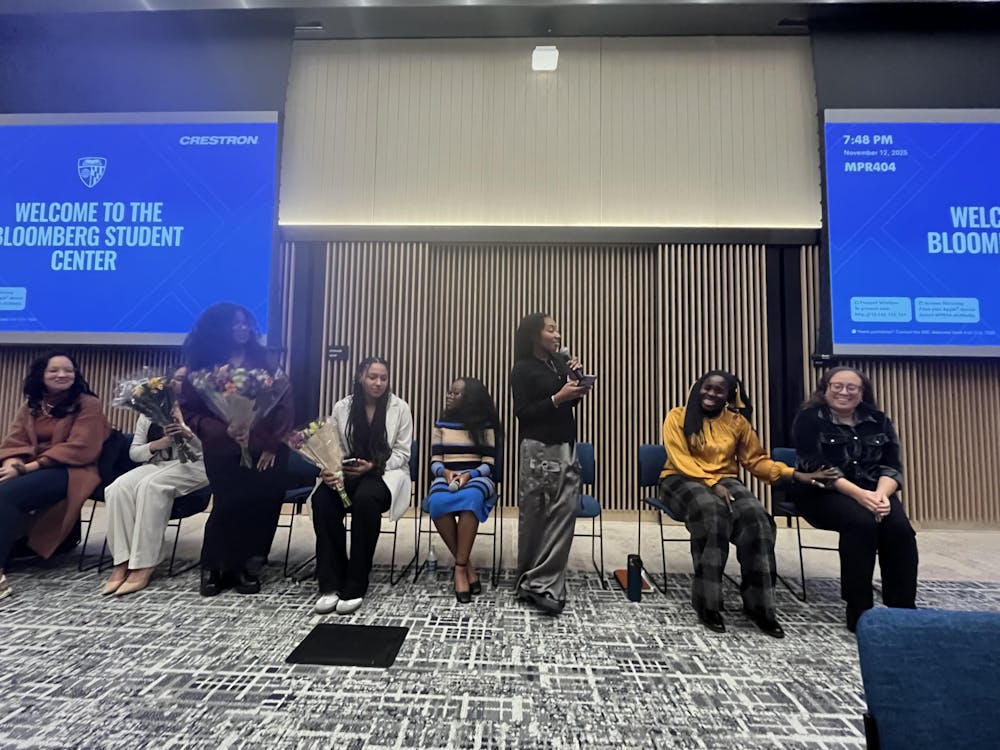The University announced the construction of the roughly 500,000 square foot Data Science and Artificial Intelligence (DSAI) building on Aug. 3, 2023. The University intends to build the institute at the intersection of Wyman Park Drive and Remington Avenue. Many neighboring residents have expressed concerns about structural damage and loss of wildlife in Wyman Park, specifically around Stony Run Creek. The News-Letter investigated student opinion on DSAI construction’s potential effects on the environment.
DSAI construction plan
The University intends the DSAI institute to include two connected buildings: north and south components. Part of the University’s Ten for One strategic plan, the DSAI will serve as a hub for data science and AI research, attracting experts in AI, machine learning, applied mathematics and computer science. The DSAI will introduce 80 new affiliated faculty positions in the Whiting School of Engineering and 30 new Bloomberg Distinguished Professors, operating with new computing power and AI technologies. Construction is expected to continue from April 2024 until summer 2029.
Senior Sabira Hassan, a chemical and biomolecular engineering major, stated that the DSAI’s approach to advancing AI technology and innovation can contribute to notable scientific progress in an email to The News-Letter.
“I know that Hopkins values innovation and curiosity, and I believe that the DSAI can help our school drive innovation in a field that the world is becoming increasingly curious about. Artificial Intelligence can advance important research, as I have seen in my recent project evaluating machine learning methods in predicting disease progression,” she wrote.
However, Hassan, alongside four other students, expressed concerns over the DSAI’s role in exacerbating environmental pollution in Wyman Park.
Environmental concerns
To construct the DSAI Institute, demolition will require the removal of 102 mature trees across Remington Avenue. While Hopkins expressed intent to plant 300 trees to replace those demolished, Hassan emphasized that surrounding community members will not see the gesture as a net positive.
“I've seen signs protesting the removal of dozens of trees to make way for the DSAI. The community members want Hopkins to leave their trees unscathed, and Hopkins has a responsibility to listen. It's hypocritical for our institution to promote mending the Hopkins-Baltimore relationship while harming the community,” Hassan wrote. “Our institution should especially understand that planting new trees does not replace the trees that have been around for decades.”
Junior Rabab Shaban corroborated the importance of trees to the local community in an email to The News-Letter.
“There has been a lot of criticism, which I do agree with, on how so many trees are being cut down causes flooding to be much more prevalent or worse as trees are very important in helping like reducing flooding and what not as it helps with the soil runoff which can be harmful to not only our community but the environment as well,” Shaban wrote.
In an email to The News-Letter, senior Zaynab Mirza shared her thoughts on other components of the environment likely affected by DSAI construction, such as the Stony Run watershed in Wyman Park.
“I know with regard to online accounts such as @bmoreagainstdsai, that DSAI has received backlash from the Remington, Hampden, and Wyman Park communities. I noticed that they argue for the protection of mature trees and the Stony Run watershed near the sites of construction, as the run-off and deforestation during and after the Institute's formation would have significant negative impacts on the environment,” Mirza wrote.
Stony Run indirectly flows into Chesapeake Bay, spreading the reach of any pollutants initially deposited. Maryland has also invested taxpayer funds into restoration projects to clean up pollutants.
Students have also shared concerns over data centers’ excessive burden on environmental resources, like electricity and water. Recent studies have shown that data centers will be the fifth largest electricity consumers worldwide, between Japan and Russia, by 2026. Mirza highlighted how this burden would fall on surrounding community members.
“Not only would this project cause disruption and damage to the trees, but the use of AI would also force Baltimore residents to limit their water and electricity consumption, despite the issue being beyond their control. Instead, Hopkins should prioritize protecting the existing ecosystem and tree canopy during the project’s construction,” Mirza stated.
Sophomore Christopher Amanat reported how he observed signs dispersed in Wyman Park, reminding him of how his local community in Tucson, Ariz. prevented the construction of an environmentally damaging data science center in an email to The News-Letter.
“We live in the Sonoran desert which is very vulnerable to drought and overuse of the water supply which meant that the community was especially sensitive to the construction of a data center,” he wrote. “Not to mention Sonoran desert has a very unique and biodiverse ecosystem that was threatened by the data center’s construction.”
While Amanat affirmed that Wyman Park and the Sonoran Desert have notable differences, both locations provide an ecological space to connect with the community and maintain livable conditions through the ecosystem.
Community members have protested against DSAI’s construction, partially due to noise and the project’s effects on local animals. For example, many local birds have regular nesting sites near the site and experience major stresses from small disturbances like drones.
In an email to The News-Letter, senior Lauren Oster highlighted environmental concerns also present with the building of the SNF Agora Institute, pushing the University to learn from community voices.
“Community members have called out JHU for being a poor neighbor and have cited past major runoff events during the construction of the SNF Agora building as precedent for concern. Facilitating the destruction of a critical public green space in an urban setting is something Johns Hopkins especially, as a beacon of medicine and public health, should be ashamed of,” Oster wrote.
The University has reported engagement with environmental impact consultants for the construction process, such as ornithologist Susan Elbin to design bird-safe exteriors. Hopkins also partnered with Steward Green, an environmental firm, to monitor local flora and fauna and ensure groundwater does not contaminate Stony Run Creek.
Construction disruption
Currently, the construction site sits close to two-story rowhouses and other neighboring buildings. Residents have expressed that DSAI construction will result in parking shortages and structural damage during community briefings. In light of community concerns, the University partnered with Seismic Surveys LLC to gather data about the structural condition of neighboring homes in early February and March this year. The specialists surveyed walls, windows and doors to ensure no negative effects from construction.
Questioning the necessity of a new building, sophomore Zehra Taqvi drew parallels between construction’s effects on Baltimore locals and Hopkins students in an email to The News-Letter.
“All of the current construction already affects our campus and neighborhoods with excessive noise and street closings, so I can’t imagine the new effects from DSAI’s construction. I don’t see the big need for a whole new building since advancing preexisting infrastructure could cost less money and serve the same process,” Taqvi wrote.
According to a University spokesperson in a February 2025 briefing, the University assured the Remington community that construction will not start before 7 a.m. and end before 5 p.m. The University has stated that DSAI construction will create 500 jobs for local construction workers, while Hopkins will create two separate satellite parking areas for the crew, to avoid filling up existing locations. The University will also recommend routes for truck drivers to minimize blockages.
While Taqvi affirmed the decision to make promises to the community, she emphasized the need for the University to maintain accountability.
“I think in any case, Hopkins should be very cognizant of the commitments they’re making regarding environmental impact, truck traffic, and construction hours. They should explicitly state how they will hold themselves accountable to their promises and regularly meet with locals to monitor any harmful effects,” Taqvi wrote.
Neighborhood Effects
The University has stated that the DSAI will bring new investments to Baltimore, increasing the economic vitality of Remington and Wyman Park neighborhoods. The influx of interdisciplinary ideas and experts hopes to transform the Baltimore region into a modern technology hub, bolstering the growth of startups, companies and jobs.
Mirza compared the DSAI initiative to the development of East Baltimore Development Inc., which displaced 900 Black homeowners and businesses to make room for a University-owned Science and Technology Park. The urban expansion initiative aimed to revitalize the neighborhoods surrounding the School of Medicine.
“This would not be the first time that Hopkins has affected neighboring communities, as the implementation of the East Baltimore Development Inc. uprooted and displaced hundreds of Black families near JHU’s medical campus. Therefore, I believe the community members’ concerns are valid considering the historic pattern of disturbance and damage to Baltimorean communities,” Mirza wrote.
Likewise, Oster also expressed worries about the gentrifying effects of the DSAI on neighboring communities, like those in Remington.
“Remington is a neighborhood facing high housing costs, pricing out longtime residents with a history of gentrification. An influx of professionals moving to the area for DSAI is sure to exacerbate these issues,” Oster stated.
Many Remington community members themselves expressed concerns that the area could see higher costs of living due to increased economic activity, forcing households to migrate from the area they lived in for decades. Some residents also reported feeling anxious about the possibility that Hopkins could try to buy their properties to support capital projects like the DSAI.
While residents said they would not support requests made by the University to obtain building permits, Hopkins has designed buildings under 65 feet that do not need zoning variances or waivers, allowing the University to continue with the construction process.
Mirza noted that this dynamic leaves locals feeling helpless toward the University’s next steps, knowing that the project will continue despite protests.
“Ignoring the concerns of local community members in numerous public hearings and regarding the environmental impact of this project showcases how powerless many Baltimoreans feel with the illusion of empathy from JHU, as the scales are skewed in the university’s favor,” Mirza commented.





